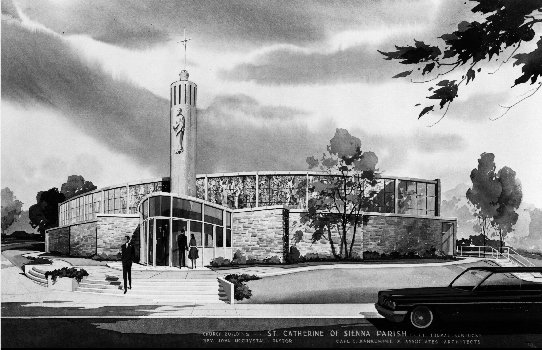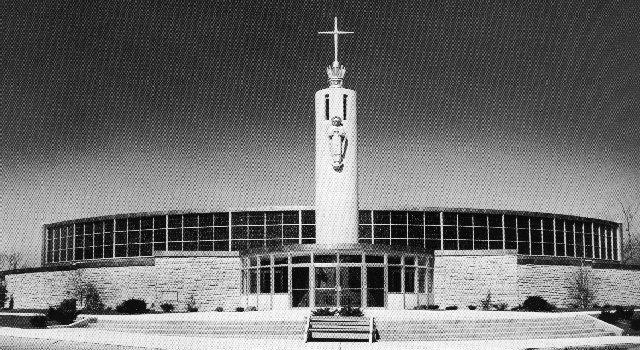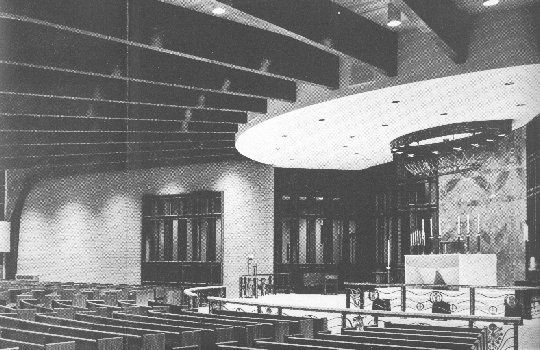
St Catherine of Sienna History
Ft Thomas
Submitted by Norb DeJaco
Information comes from the St Catherine of Sienna
Dedication Book 1963
HISTORY OF THE PARISH
Families who lived in Ft. Thomas in 1930, frequently passed the familiar grassy,
tree-bordered four acres of land at the corner of North Ft. Thomas and Rossford
Avenues. The Most Reverend Francis W. Howard, Bishop of Covington, saw something
here that others did not. There was need of a new parish in Ft. Thomas. This
would be the ideal site for the new church.
Early in 1930, the property was acquired, along with a nearby house that was to
serve as a temporary church and rectory. On August 15, 1930, the Feast of the
Assumption of the Blessed Virgin Mary, Bishop Howard announced the establishment
of the new parish, St. Catherine of Siena. The lower floor of the newly acquired
building served as a chapel for the sixty families that lived in the area
at the time. This is the same building that is still used today as the St.
Catherine Rectory.
The first Mass was offered in the little chapel on the Feast of Christ the King,
October 26, 1930. Devotions were observed in this building for three and a half
months, when a small frame church was built and dedicated by Bishop Howard on
February 8, 1931.
During these early days of the parish St. Catherine’s had no school. The
children continued to attend the schools in their previous parishes; namely, St.
Thomas in Ft. Thomas, Sacred Heart and St. Anthony in Bellevue, and St. Bernard
in Dayton. We of St. Catherine will always be grateful to the pastors of these
parishes for their gracious generosity in allowing our children to attend their
parochial schools tuition free.
The church and school functioned in this manner for seventeen years, then Bishop
William T. Mulloy gave the commission to build a school in St. Catherine’s
parish. One year later, while Bishop Mulloy was in Rome, the new school building
was dedicated and Monsignor Herbert F. Hillenmeyer presided at the laying of the
cornerstone. The school was opened in September, 1949, with four classrooms for
the eight grades. Three Sisters of Charity of Nazareth were assigned to the
school. The principal was Sister Jerome. It was necessary for these Sisters to
travel to and from school each day by bus from the Immaculate Conception Convent
in Newport, since we had no convent at St. Catherine’s.
The facilities at Immaculate Conception were provided through the generosity of
Monsignor Gerhard H. Geisen.
We did, however, have a large and well equipped auditorium on the ground floor
of the school which served as a cafeteria and a meeting hall for the societies
and for all the social events which took place
in the parish.
As the parish grew and the original number of 66 pupils in the school increased,
a second floor of classrooms was added to the school building. A larger
faculty was also needed, of course, and five lay teachers were added to assist
the four Sisters of Charity then attending to the educational needs of our
children. The present enrollment is 360. About the same time the school
and faculty were enlarged, the parish also acquired a residence for the Sisters’
use. As was the case with the school, the little church became increasingly
inadequate to meet the needs of our congregation. By 1960, it was apparent that
a new building would be required. We were, therefore, commissioned by the
present Bishop, the Most Reverend Richard H. Ackerman, to erect a church that
would accommodate all the members of the parish. Ground was broken on April 1,
1962. A little over one year later, on July 19, 1963, we moved into the basement
of the new church. The old church was immediately dismantled to provide a
recreation area for the children and increased parking for cars.
From this point on the building program at St. Catherine’s was swift moving.
And, five months later, on Christmas Day, Solemn High Mass was celebrated in the
beautiful new upper church for the first time, to the joy and satisfaction of
all concerned.

Original design by Carl
Bankemper
THE DESIGN OF THE CHURCH

When thoughts of the parish turned to a new St. Catherine of Siena Church, there
was a feeling that whatever was built should boldly challenge the future even as
it faithfully interpreted the ancient traditions of the Roman Catholic Church as
prescribed in Canon Law and Sacred Liturgy.
We rejoice that we have been able to build such a church. Even from a distant
approach, it is immediately interesting and beautiful. With its gleaming bell
tower of limestone bearing in relief the image of the church’s patroness, St.
Catherine . . . with its distinctive quarter-round front (joining together in
the rear to form a gigantic triangle) and with its high wall of art glass
windows . . . it is an
inspiring sight to any worshiper.
As you come closer and enter the baptistery, tradition quickly makes its
presence felt, with the covered ‘‘cloister’’ or ambulatory leading to the open
expanse of the great nave, just as it does in many of the great buildings of the
Latin Rite Church of the Old World.
You will note, too, that the new St. Catherine of Siena Church is faithful to
the Canon Law which admonishes that all who enter shall focus on the center of
the church—the altar. Indeed, the circumferential theme with its focus upon the
altar, is carried out throughout the building with the result that all are
brought closer to the heart of the Sacrifice. (No one is farther from the
sanctuary than fifty feet!) The Way of the Cross, and the Sacraments of Baptism
and Penance take place in the ambulatory before entering the nave.
It is of special interest that the front exterior of the church is constructed
of St. Meinrad sandstone, cut and quarried by the monks at St. Meinrad Abbey,
St. Meinrad, Indiana, where today’s celebrant Joseph Cardinal Ritter, and our
Pastor, Rev. John McCrystal, attended Preparatory Seminary. The side exterior
walls are of red brick, conforming with the brick of the school.
It will be noted that directly above and slightly to the rear of the front, the
colorful art glass windows take on added distinction and, beauty in their
framing of extruded aluminum. The center theme of the windows is the Last
Supper. Saints who have had great relationship to the Holy Eucharist are seen on
either side. The church’s patroness, St. Catherine of Siena, can be seen in
symbols and in relief, not only outside, but inside the church. Her image,
directly below the cross and crown of thorns on top of the bell tower, was
quarried and carved in Italy, the quarry being just 50 miles from St.
Catherine’s
home city of Siena.

St. Catherine is again seen in the mosaic mural immediately inside the main
entrance. Here she symbolically leads the members of the parish to the
Church—St. Peter’s Basilica—through Mary, Mediatrix of all Graces—to God.
In the design of the church, the importance of the Sacrament of Baptism has been
emphasized by special attention to the baptistery. The railing and gate of
bronze and wrought iron signify that this is a holy place. The font is of marble
and the floor of the font area is sunken to suggest a lowering
into the River Jordan, where Christ, Himself, was baptized by St. John.
The circumferential ambulatory runs the width of the building and was purposely
kept low to prepare all who enter to move farther into the nave of the church as
tradition has prescribed. Confessionals line the walls to both sides of the main
entrance . . . and to the west is the soundproof cry room. The confessionals,
doors and all bulkheads are of walnut.
Seven aisles lead into the nave and in keeping with the design, the width of the
pews decreases as you approach the front of the church. The choir, at the side
of the altar, conforms to liturgy. Twelve heavy laminated arches of
walnut-stained fir support the roof. These originate in the curved ambulatory
and
converge above the altar. The reredos, forming a screen behind the altar,
is of rosara marble. The baldachin and tester above the altar are made of bronze
and wrought iron. The baldachin symbolizes the majesty of Christ the King. St.
Catherine of Siena’s symbols, heart and cross, appear on
the tester—the metal crown. Fleur de lis on the baldachin is a symbol of the
Trinity.
The interior sidewalls of the church are of green glazed brick and the pews are
of walnut. The altar and communion rails are of wrought iron and bronze,
highlighted in green to match the glazed brick. Seating capacity is 725.